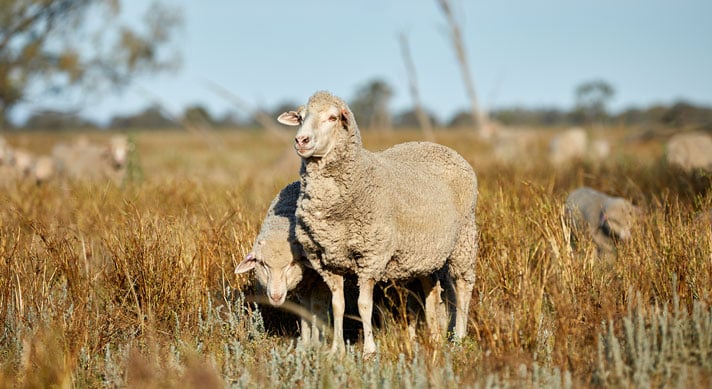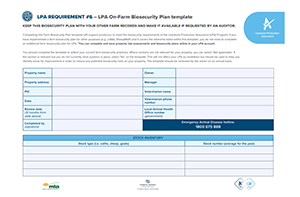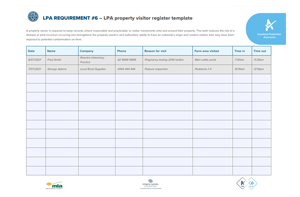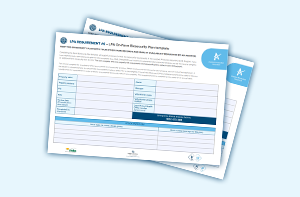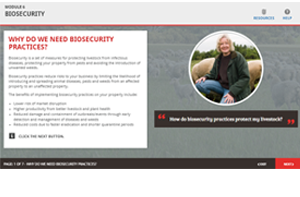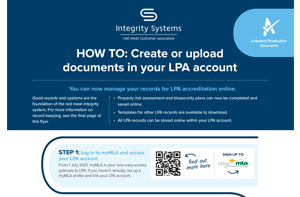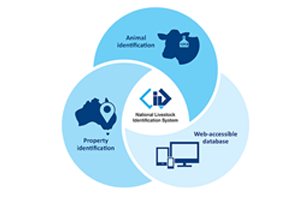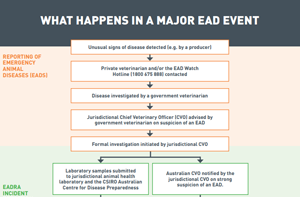
Foot and mouth disease: What you need to know
Foot and mouth disease (FMD) is a highly contagious animal disease that affects cattle, sheep, goats and pigs.
FMD can spread through close contact between animals and be carried on animal products or by the wind. The virus is excreted in breath, saliva, mucus, milk and faeces of affected animals.
The disease causes foot lesions which leave animals lame and unable to walk to feed or water. In addition, tongue and mouth lesions can cause animals to drool and stop eating.
Adults usually recover and begin eating again after a few days, but young animals may weaken and die, or be left with foot deformities or damage to the mammary glands.
Human infections have been reported but they are very rare and do not result in serious disease. There are no safety implications for the human food chain from an outbreak of FMD.
What you need to know about FMD
Lumpy skin disease: What you need to know
Lumpy skin disease (LSD) is a viral disease of cattle and buffalo that originated in Africa and has since spread to Southeast Asia, including Indonesia.
The disease is spread primarily by biting insects such as certain species of flies, mosquitoes and ticks.
The disease can also be spread by fomites through such things as contaminated equipment and in some cases directly from animal to animal.
Infection typically causes an acute disease with fever, depression, and characteristic skin nodules. There may also be a marked reduction in milk yield as well as abortion in pregnant animals. It has a low mortality rate but can cause significant animal welfare concerns and production loss.
It does not pose a risk to human health.
What to do if you suspect an infection
Regularly inspect your livestock for ill health and disease and if you observe any unusual signs of disease in your livestock, or if you suspect FMD or LSD, immediately call the Emergency Animal Disease Watch Hotline on 1800 675 888.
Good biosecurity practices and early detection will be essential to reduce the potential impact of FMD or LSD, should either arrive in Australia.
Call the Emergency Disease Watch Hotline on 1800 675 888
State and territory department contact information
Open borders and livestock standstills
While Australia’s border control works to stop biosecurity threats entering Australia – including meat products, foreign soils and other organics – everyone in the industry must do their part to maintain a high level of security.
With more international travellers arriving in Australia for tourism and work, it is important that anyone who enters a farm or production space has been tested for risks, and there are biosecurity measures in place. Make sure that, when reasonable, you are controlling who is entering the property, and any possible contaminations they may bring, including soil from shoes, exotic diseases and other foreign materials.
In the event of large-scale disease outbreak, your state department of primary industries may call for a livestock standstill, also known as a movement restriction, to prevent further disease spread through the value chain. This stop in transportation gives responders time to conduct investigations, trace infected animals and test for further contamination.
For more information read our article on livestock standstills
FAQs
Australia is currently free from FMD and LSD and our priority is to keep it that way. At the same time, while we are confident in Australia’s strong biosecurity measures, we aren’t taking anything for granted.
State and Federal governments are undertaking a range of activities to manage the biosecurity risks posed by LSD and FMD and are actively engaged with industry on prevention and planning.
MLA in conjunction with the Australian Government, is working closely with the Indonesian Government and industry via a biosecurity support program to help control the spread of FMD and LSD in Indonesia.
A joint industry taskforce has been established to ensure coordination and collaboration across all affected industry sectors, comprised of the Red Meat Advisory Council, National Farmers’ Federation, Australian Dairy Farmers’ and their respective industry service providers. Four skills-based committees have been set up by the taskforce covering overseas in-country support; trade and protocols; diagnostic capability and vaccine development; and domestic containment strategies.
There is a clear and robust plan in place, known as the Australian Veterinary Emergency Plan (AUSVETPLAN).
Regularly inspect your livestock for ill health and disease and understand how to report a suspected infection. If you observe any unusual signs of disease in your livestock, or if you suspect FMD or LSD, immediately call the Emergency Animal Disease Watch Hotline on 1800 675 888, your local veterinarian or your state department.
The best chance of being able to contain and eradicate an FMD or LSD incursion will rely on early detection and reporting.
Call the Emergency Disease Watch Hotline on 1800 675 888
States and territories have different biosecurity requirements. State and territory government agencies often require movement documents, such as animal health declarations, for movement of livestock into their jurisdiction. They may also require testing and/or certification.
Before moving any livestock to a different state/territory, owners should check the requirements with a local animal health officer or on the relevant state or territory website:
To meet the requirements of LPA, each Property Identification Code (PIC) must have a formal, documented Farm Biosecurity Management Plan that addresses each of the following:
- Manage and record the introduction and movement of livestock in a way that minimises the risk of introducing and/or spreading infectious diseases.
- Where reasonable and practical, control people, equipment and vehicles entering the property to minimise the potential for property contamination and, if possible, keep a record of such movements.
- Prevent and control animal diseases on-farm by regularly monitoring and managing livestock.
Create your own on-farm biosecurity management plan
In the event of an incursion, an amalgamated PIC (multiple properties listed under one PIC) is still treated as one single property, regardless of boundaries or size.
All livestock across the properties will be subject to the same quarantine requirements or ability to trade or move livestock.
In most instances, organisations such as power and water companies have a legal right to enter your property, even without notice.
To reduce the risk to biosecurity it is best to contact the companies and express your concerns about biosecurity and any measures they can undertake to reduce the risks. As well as this, ensure biosecurity signage is prominent on your boundary fences and gates to encourage visitors to contact you on arrival.
You can also increase inspection of the livestock and property in these areas for early signs of any issues.
If you know a visitor has entered your property, record their movements in case of hazards. Signs can be found at Animal Health Australia.

